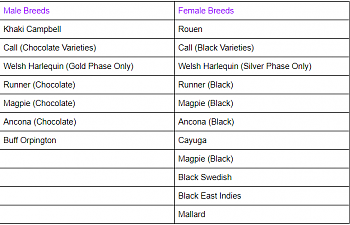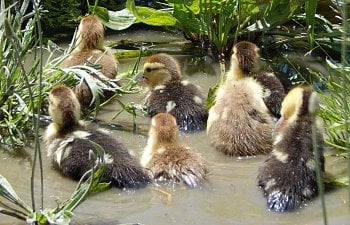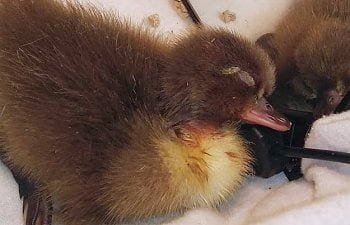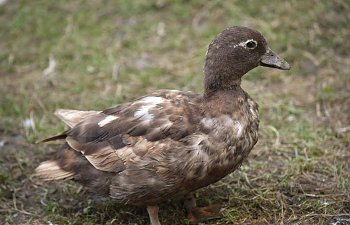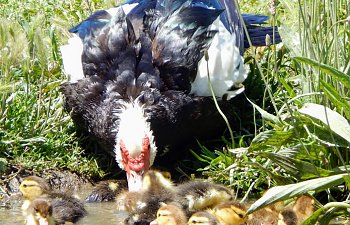Breeding for Sex-Linked Ducklings

If you've ever bought chicks at a feed store or ordered them from a hatchery, you have probably come across birds labeled as Red Stars, Black Stars, Cinnamon Queens, ISA Browns, and the like. All of these are trade names for red sex link and black sex link chickens - that is, chickens that are bred specifically so that you can tell what gender they are at hatch depending on what color their down is.
If you raise and breed ducks, you might wonder if you could do the same; if you could breed ducklings that would hatch so that you can tell their gender right off the bat, without having to vent sex or wait to see if they quack or get a drake feather or, in the case of muscovies, wait until they grow enough that you can see the differences between the males and females.
The good news is, you absolutely can! Ducks have a sex-linked color gene called chocolate. Both muscovies and mallard-derived ducks have a chocolate gene that works in the same way, so this method of breeding for sex-linked ducklings will work for both.
Chocolate is a recessive gene that is linked to the Z chromosome. Birds are different than mammals in that their chromosomes are ZZ for the male, and ZW for the female.
Being recessive, chocolate usually would require two copies to express, and this is true for male ducks, since they have two Z chromosomes. Females, however, only have one Z chromosome, and due to that, they can only ever get one copy of chocolate, so it expresses with a single recessive copy.
Chocolate Call Female
Using this fact, we can cross a chocolate drake to a female that is not chocolate, and the result is male offspring that received only one copy of chocolate, thus making them not chocolate, and female offspring that all received the one copy they needed to be chocolate, making all the females chocolate.
This is because the female is the one that provides the chromosome that determines the sex of the ducklings. Each of her eggs is either a W chromosome, which is destined to be female, or a Z chromosome, which is destined to be male. So her female offspring can never receive a Z chromosome from her. They can only receive a Z chromosome from their father, which in this case will be carrying the one chocolate gene that will make them chocolate.
Chocolate Bibbed Call Duckling
Here is a chart displaying how this works. As you can see, the male gives one of his Z chromosomes carrying chocolate to his daughters, making them chocolate. Meanwhile the female gives her Z chromosome, which is not carrying chocolate, to the male offspring, meaning that they cannot be chocolate.
This will always work, but there are some color females you want to avoid.
Mallard-Derived Ducks
In mallard derived breeds, it's best to avoid using any female (and, in fact, male) that has the blue dilution gene. This is because it can be hard to tell which ducklings from such a cross are blue or silver (males) and lilac or lavender (females) at hatch, since the down color is similar. The sex linking will still work, you just might not be able to tell which ducklings are which color at hatch, and that defeats the point.
You also want to avoid using a white female. This is because white is epistatic to all other colors - meaning no matter what color the duck would have been otherwise, if it gets two white genes, then it's going to be white. And it's recessive, so if your drake happens to be carrying a copy of it without your knowledge, then half the ducklings would be white, and there would be no way to sex them by down color. Plus, if you don't know the parentage of your female, it's possible that she is chocolate 'under' the white, which makes her unusable for sex-linked ducklings.
To make it a little easier, here is a list of breeds of duck that will be easiest for using to breed for sex linked ducklings. Some breeds of course come in multiple colors, so the colors you would want to use are also noted with the breed. Any male from this chart bred to any female will produce sex linked ducklings.
When starting out, you might have trouble telling down color apart on males and females that aren't just solid black or solid chocolate as ducklings, so for the easiest sex linking, try to use either a male or female (or both) whose color is based on extended black, so that all the ducklings will be solid colored. But all the combinations will work. If you don't know what extended black is, see this article.
This chart is by no means inclusive - it just contains the breeds and colors that are easiest to start with. Any male at all that is a color that includes the chocolate gene will work, just as any female whose color does not include the chocolate gene will work.
Muscovy Ducks
For muscovies, things are a little different. Just as with mallard-derived breeds, you need the male to be chocolate and the female not to be. However, the genetics for other colors in muscovies work differently than in mallard ducks, so it isn't the same as to which colors you should avoid using for a sex linked cross.
For one, white in muscovies is different. It is dominant, not recessive. One copy makes a bird pied, and two makes it completely white. Therefore, if you are using a chocolate pied male, you should not use a pied female, since a quarter of their offspring would then be solid white, and impossible to sex by down color. You can use a pied male with a solid female, or a solid male with a pied female, but both cannot be pied.
Along the same vein, it is not advised to use a white male or female, unless you know for a fact that 'under' the white they are the proper colors because you know their parentage. And if you do know they are the proper color, they should only be mated to a solid colored duck. All the offspring would be pied in that case and you would be able to sex by down color.
Muscovy duck with her sex-linked ducklings
Like mallard derived ducks, muscovies also have other color genes that can interact with chocolate to make new colors. Lavender, for example, will interact with chocolate to make cream. There are also sepia genes and blue dilution genes too. I will admit muscovies are not my area of expertise, so I do not know how hard it would be to distinguish, for example, a cream duckling from a lavender duckling, but it might be difficult. For simplicity's sake it would probably be better to avoid using colors other than chocolate and black. All the pattern genes though, like barred and ripple, should be fine to use since those will not change the color of the duckling's down.
Conclusion
Breeding sex-linked ducklings is as easy as breeding a chocolate male to a non-chocolate female. If you found the color genetics behind this interesting and would like to learn more, this article will teach you all about the genetics behind colors in mallard-derived breeds. You can also check out the Ducks section here on BYC.

